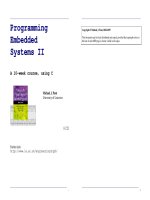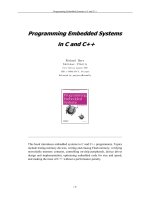CS222: Systems Programming
Bạn đang xem bản rút gọn của tài liệu. Xem và tải ngay bản đầy đủ của tài liệu tại đây (678.2 KB, 29 trang )
CS222:
Systems Programming
Memory Management
February 19th, 2008
A Designated Center of Academic Excellence in Information Assurance Education by the National Security Agency
Last Class
Error Handling
– Exception Handling
– Console Control Handlers
– Vectored Exception Handling
CS222 - Systems Programming
2
2/23/2008
Today’s Class
Memory management
–
–
–
–
Overview
Heap management
Memory-mapped files
Dynamic link libraries
CS222 - Systems Programming
3
2/23/2008
Memory Management I
A Designated Center of Academic Excellence in Information Assurance Education by the National Security Agency
Process and Memory Space
Each process has its own virtual address space
– Up to 4 GB of memory (32-bit)
• Actually 2GB (3GB possible)
All threads of a process can access its virtual
address space
– However, they cannot access memory that belongs to
another process
CS222 - Systems Programming
5
2/23/2008
Virtual Address Space
Virtual address of a process does not
represent the actual physical location of an
object in memory
Each process maintains its page map
– Internal data structure used to translate virtual
addresses into corresponding physical addresses
– Each time a thread references an address, the
system translates the virtual address to physical
address
CS222 - Systems Programming
6
2/23/2008
Virtual and Physical Memory
Virtual address space of a process can be smaller or
larger than the total physical memory available on the
computer
The subset of the virtual address space of a process
that resides in physical memory is called working set
– If the threads of a process attempt to use more physical
memory than is currently available, then the system pages
some memory contents to disk
CS222 - Systems Programming
7
2/23/2008
Pages
A page is a unit of memory, into which
physical storage and the virtual address
space of each process are organized
– Size depends on the host computer
When a page is moved in physical memory,
the system updates the page maps of the
affected processes
When the system needs space in physical
memory, it moves the least recently used
pages of physical memory to the paging file
CS222 - Systems Programming
8
2/23/2008
Page State
The pages of a process’s virtual
address space can be in one of the
following states
– Free
• Neither committed nor reserved, but available
• Not accessible to the process
• Attempting to read from or write to a free page
results in access violation exception
• VirtualFree or VirtualFreeEx
CS222 - Systems Programming
9
2/23/2008
Page State, cont
– Reserved
• Reserved for future use
• Address range cannot be used by other allocation
functions
• Not accessible and has no physical storage associated
with it
• Available to be committed
• VirtualAlloc or VirtualAllocEx
– Committed
• Physical storage is allocated, and access is controlled
• When process terminates, it is released
• VirtualAlloc or VirtualAllocEx
CS222 - Systems Programming
10
2/23/2008
Page State, cont
CS222 - Systems Programming
11
2/23/2008
Scope of Allocated Memory
All memory allocated by memory allocation functions
– Is process-wide
– HeapAlloc, VirtualAlloc, GlobalAlloc, LocalAlloc
All memory allocated by a DLL is allocated in the
address space of the process that called the DLL
In order to create shared memory, we must use file
mapping
CS222 - Systems Programming
12
2/23/2008
Page Faults
References to pages not in memory
– Most virtual pages will not be in physical memory
– OS loads the data from disk, either from
• System swap file, or
• Normal file
For performance purpose, programs should be
designed minimize page faults
CS222 - Systems Programming
13
2/23/2008
GetSystemInfo
A function returning information about the current
system
– SYSTEM_INFO structure contains information including the
architecture and type of a processor, the number of
processors, page size, etc
VOID GetSystemInfo(
LPSYSTEM_INFO lpSystemInf);
CS222 - Systems Programming
14
2/23/2008
Example: GetSystemInfo
void main()
{
SYSTEM_INFO siSysInfo;
GetSystemInfo(&siSysInfo);
// Display the contents of the SYSTEM_INFO structure.
printf("Hardware information: \n");
printf(" OEM ID: %u\n", siSysInfo.dwOemId);
printf(" Number of processors: %u\n",
siSysInfo.dwNumberOfProcessors);
printf(" Page size: %u\n", siSysInfo.dwPageSize);
printf(" Processor type: %u\n", siSysInfo.dwProcessorType);
printf(" Minimum application address: %lx\n",
siSysInfo.lpMinimumApplicationAddress);
printf(" Maximum application address: %lx\n",
siSysInfo.lpMaximumApplicationAddress);
printf(" Active processor mask: %u\n",
siSysInfo.dwActiveProcessorMask);
}
CS222 - Systems Programming
15
2/23/2008
Example: GetSystemInfo
CS222 - Systems Programming
16
2/23/2008
Windows Memory Management
C Library
Windows Program
Heap API
MMF API
Virtual Memory API
Windows Kernel with
Virtual Memory Manager
Disk & File
System
Physical Memory
CS222 - Systems Programming
17
2/23/2008
Heaps
A heap is used for allocating and freeing objects
dynamically for use by the program. Heap operations
are called for when
– The number and size of objects needed by the program are
not known ahead of time
– An object is too large to fit into a stack allocator
CS222 - Systems Programming
18
2/23/2008
Heap Management
A process can contain several heaps for following
reasons
–
–
–
–
–
Fairness
Multithreaded performance
Allocation efficiency
Deallocation efficiency
Locality of reference efficiency
Often a single heap is sufficient. In that case, use the
C library memory management functions
– malloc, calloc, realloc, free, etc
CS222 - Systems Programming
19
2/23/2008
GetProcessHeap
A function used for obtaining a handle to the heap of
the calling process
– Heap handle is necessary when you are allocating memory
– Each process has its own default heap, which is used by
malloc
HANDLE GetProcessHeap( VOID );
Return: The handle for the process’s heap: NULL on failure
CS222 - Systems Programming
20
2/23/2008









